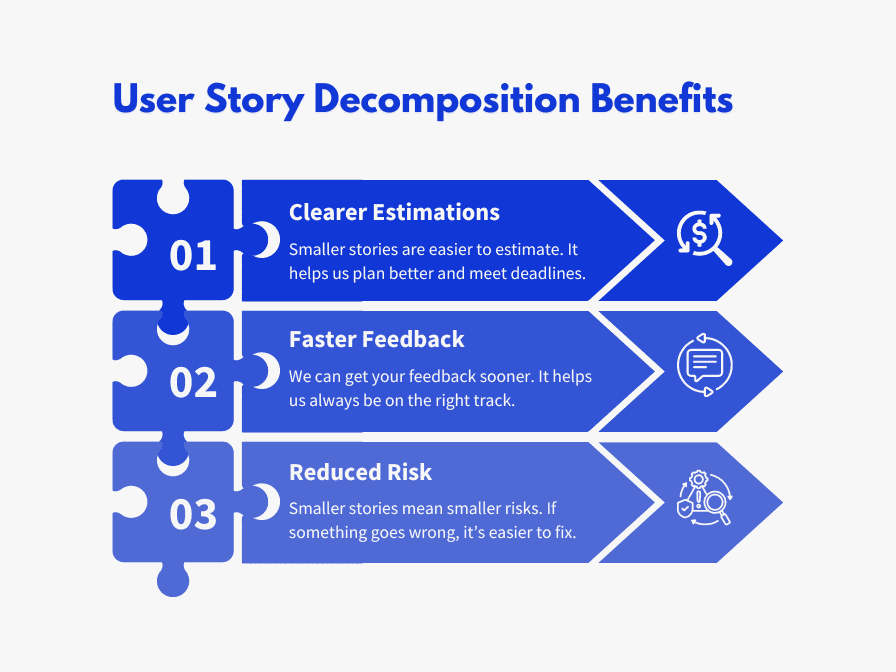Ever tried moving a boulder uphill? Yeah, not fun. That’s what working with oversized user stories in custom software development feels like — slow, heavy, and full of frustration. Good (we mean, smart) developers know the trick: split those stories down into smaller, manageable pieces. Suddenly, you’re moving faster, hitting milestones, and dodging the chaos that comes with giant, clunky tasks, while speed, quality, and agility remain your friends.
Let’s break down why this method works and how it can save your next project from rolling off the rails.

Why Do We Need to Split User Stories?
Imagine trying to eat a whole pizza in one bite. Impossible, right? The same goes for user stories in creating software development. When we break them down into smaller, manageable pieces, we can:
1. Make better estimations. It’s much easier to calculate how much time the team will need to perform a small task rather than a large, ambiguous feature.
2. Deliver faster. Smaller stories mean quicker completion. We can roll out features incrementally, giving you and your users value sooner.
3. Improve quality. With smaller chunks, our team can focus better, test thoroughly, and catch issues early.
4. Enhance flexibility. Smaller stories allow us to adapt to changes easily. If priorities shift, we can pivot without derailing the entire project.
5. Boost morale. Completing smaller tasks gives the team a sense of accomplishment and keeps motivation high.
How Do We Split User Stories?
Splitting user stories is like building with LEGO blocks. Each piece is small and manageable, but together, they create something amazing. This approach helps us deliver high-quality software with unmatched speed.
We aim for vertical slices. This means each piece is a complete, usable feature from the user interface down to the database. Think of it like slicing a cake vertically so each slice has frosting, filling, and cake — a full experience in every bite.
What are the Benefits of User Story Decomposition?
1. Clearer Estimations
Smaller stories are easier to estimate. It helps us plan better and meet deadlines.
2. Faster Feedback
We can get your feedback sooner. It helps us always be on the right track.
3. Reduced Risk
Smaller stories mean smaller risks. If something goes wrong, it’s easier to fix.

INVEST in Good User Stories
Bill Wake, a pioneer of Extreme Programming, introduced the INVEST model to help teams craft better user stories. INVEST stands for six key attributes that make a user story clear, actionable, and effective. Here’s what each characteristic means.
📌 I for Independent
Stories should be self-contained so you can prioritize them without dependencies.
📌 N for Negotiable
Stories should be flexible for collaboration and refinement.
📌 V for Valuable
Each story must deliver visible value to the user.
📌 E for Estimable
Stories should be clear enough to estimate their size and effort.
📌 S for Small
Stories should be small enough to fit several into a sprint.
📌 T for Testable
There should be clear criteria to verify the story is complete.
Many beginner agile teams try to split user stories by architectural layers: one story for creating a user interface, another for the database, and so on. While this approach may satisfy the “Small” criterion, it often fails to meet the “Independent” and “Valuable” criteria.
“User story splitting isn’t just a technical exercise; it’s an art form that requires a deep understanding of both the user and the code.”
How Small Should It Be?
Aim for 6–10 stories per iteration. The size depends on your team’s velocity. Before sprint planning, figure out the estimate that signals a story needs splitting. For most teams, that’s 8 or 13 points. In some projects, we split stories even at 5 points, depending on the project structure.
Which Pattern Should You Use?
You might find multiple ways to split a story. Here’s how to choose.
1️⃣ Prioritize or Discard
The 80/20 rule says most value comes from a small part of the functionality. Choose the split that reveals low-value stories you can drop.
2️⃣ Even Sizes
A split that turns an 8-point story into four 2-point stories is better than a split into 5 and 3 points. It gives the Product Owner more flexibility to prioritize.
We do. Get the first estimate for free.
User Story Splitting Patterns
In years of working with agile methodologies, we’ve identified nine patterns for breaking down user stories into good, small units.
Workflow Steps
Take a CMS user story: “As a content manager, I can publish content on the company page.” Seems straightforward, right?
But digging deeper, you find it involves editor and legal approvals, plus a test environment check. You can’t cram all that into one iteration.
Solution: Start with a basic end-to-end scenario, then add the intermediate steps. Here’s how you can split it:
- “I can publish content directly on the company page.”
- “I can publish content with legal review.”
- “I can publish content with editor review.”
- “I can preview content on the test environment.”
- “I can publish content from the test environment to the main server.”
Simple/Complex
During planning, stories can balloon with questions like
“What about X?”
or
“Did you consider Y?”
To keep things manageable, ask, “How can we make this as simple as possible?” Write this simple version as a separate story. Define its completion criteria to keep it simple, then split variations and complexities into separate stories.
For example: “As a user, I can search for flights between two destinations.”
Split it into:
- “… specifying the maximum number of layovers.”
- “… including nearby airports.”
- “… using flexible date ranges.”
- and so on.
Business Rule Variations
Consider a story: “As a user, I can search for flights with flexible dates.”
“Flexible dates” hides multiple business rules, each worth its own story:
- “N days between X and Y”
- “± N days from X and Y”
- “Weekends in June”
Operations
The word “manage” in a user story indicates multiple operations. This suggests an obvious way to split the story.
For example: “As a user, I can manage my account.”
Split it into:
- “… I can log in using my account.”
- “… I can edit my account settings.”
- “… I can delete my account.”
Major Effort
Take a credit card processing scenario: “As a user, I can pay for my ticket with MasterCard, VISA, American Express, or Diners Club.”
You can split this into four stories, one for each card type. But the heavy lifting (payment processing) is done in the first story, making the rest easy.
Solution: Defer the decision on which card to implement first:
- “I can pay with one of the cards (MC, VISA, AMEX, DC).”
- “I can pay with all four cards (MC, VISA, AMEX, DC)” (once one card payment is implemented).
This way, dependencies are clearer, and you can adjust priorities as needed.
Data Variations
Story complexity often comes from data variations. For example, a system that maps areas served by transport providers could get overwhelmed by geographic data.
Consider: “As a user, I can search for carriers by departure and destination.”
Without a sophisticated Geographic Information System (GIS), modeling geography is complex. So, simplify: “As a user, I can search for carriers by departure and destination country.” As you gather more data, you might find carriers serve specific cities or regions.
Then, split into:
- “As a user, I can search for carriers by countries, cities, or regions of departure and destination.”
- “Carriers can serve different geographic areas as departure and destination points.”
Classic localization stories also fit here:
- “… in English.”
- “… in Slovenian.”
- “… in Korean.”
- and so on.
Input Methods
Complexity often comes from the user interface, not the functionality. Start by creating the simplest interface, then focus on making it more attractive and user-friendly. These steps depend on each other, but the split still works effectively.
For example: “As a user, I can search for flights between departure and destination points.”
Split it into:
- “… using simple date input.”
- “… using a visualized calendar.”
Postpone Performance
Sometimes, making functionality fast takes a lot of effort, while the core development isn’t that complex. You can gain more by developing a slow version that still provides value to users. Split the story into “make it work” and “make it fast.”
For example: “As a user, I can search for flights between departure and destination points.”
Split it into:
- “… (slowly — just make the search work, show a ‘processing’ animation)”
- “… (in less than 5 seconds).”
Separate the Spike
A user story might be big not just because it’s complex but because the implementation format is unclear. In such cases, splitting it won’t help. Instead, do a time-boxed spike to clear up any development uncertainties. After that, you’ll be ready to move forward or decide how to split the story.
For example: “As a user, I can pay for my order with a credit card.”
Split it into:
- “Research credit card processing.”
- “Implement credit card processing.”
For a “research” story, the completion criterion should be the specific question you’re trying to answer. Do just enough research to answer that question and then stop — it’s easy to lose focus during research.
| ❕ The spike separation approach is mentioned last because it should be a last resort. Usually, you know enough to start developing something. Do that first, and you’ll learn more as you go. Try using any of the previous eight patterns before resorting to a spike. |
Final Thoughts
At Rocketech, we dissect user stories with precision, turning complex requirements into focused, actionable components. Our method isn’t just about meeting deadlines — it’s about creating a format that enhances estimation accuracy and development speed while following the highest industry standards.
For example, by splitting stories into vertical slices, we deliver fully functional features faster, whether it’s refining a payment gateway or optimizing a multi-step workflow. When your business needs rapid results without sacrificing quality, we make sure your product hits the market ahead of schedule.
We can help! Talk to our experts to get a free project estimation.